
Rasmus Malling-Hansen
Encyclopedia


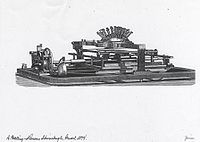
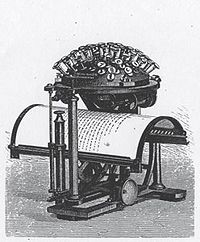
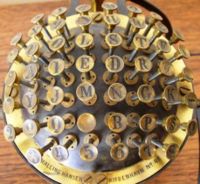
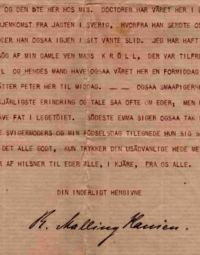
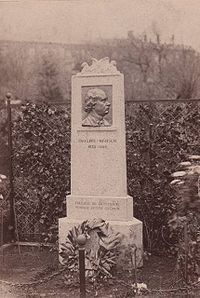
Inventor of the world's first commercially produced typewriter
Malling-Hansen's most famous invention was the Hansen Writing BallHansen Writing Ball
The Hansen Writing Ball was invented in 1865 by the reverend and principal of the Royal Institute for the deaf-mutes in Copenhagen, Rasmus Malling-Hansen, 1835-1890. The writing ball was first patented and entered production in 1870, and was the first commercially produced typewriter. In Danish it...
, invented in 1865 and first patented and put into production in 1870. From Malling-Hansen's daughter, Johanne Agerskov
Johanne Agerskov
Johanne Elisabeth Agerskov , daughter of the Danish inventor Rasmus Malling-Hansen, was a Danish intermediary. Together with her husband, Michael Agerskov, she was responsible for the ethic-religious, philosophic and scientific book, Toward the Light , first published by Michael Agerskov in...
's book, Hvem er Skrivekuglens Opfinder? we know that Malling-Hansen in 1865 made experiments with a model of his writing ball, made of porcelain. He marked the letters on the model, and while his brother-in-law recorded the time, he tried to write as fast as he could with different placements of the letters. In this way, he found an arrangement of letters on the keyboard that made the writing speed very fast. He positioned the most frequently-used letters to be manipulated by the fastest writing fingers, with vowels to the left and consonants to the right. This, together with the placement of the letters on short pistons, made the Hansen Writing Ball a very fast speed writing machine. On the first model, the paper was attached to a cylinder, which moved by the help of an electromagnetic battery, making the writing ball in principle also the first electric typewriter. The writing ball is characterized by its finely crafted mechanical details. Malling-Hansen developed his invention further throughout the 1870s and '80s, and in 1874 he patented a new model in which the cylinder was replaced by a flat carriage on which the paper was fastened. In 1875 the writing ball found its well-known tall shape. With this model, Malling-Hansen found a mechanical solution for the movement of the paper, dispensing with the battery. The writing ball was sold in many countries in Europe, but probably due to the relatively high price, it was never a great commercial success. Even so, it was a great success in different exhibitions, and Malling-Hansen received the first prize medal at a large industrial exhibition in Copenhagen in 1872, and at the world exhibitions in Vienna
Weltausstellung 1873 Wien
]The Weltausstellung 1873 Wien was the large World exposition was held in 1873 in the Austria–Hungarian capital of Vienna. Its motto was Kultur und Erziehung ....
in 1873, and in Paris
Exposition Universelle (1878)
The third Paris World's Fair, called an Exposition Universelle in French, was held from 1 May through to 10 November 1878. It celebrated the recovery of France after the 1870 Franco-Prussian War.-Construction:...
in 1878. Malling-Hansen in 1872 also invented a fast speed writing machine to be used for stenography, called the Takygraf. We know the patent application for this machine, and there also exist pictures of it, so at least one specimen must have been made. But nobody knows where this Takygraf is today. Malling-Hansen was also the first person to discover the unique possibilities of blue carbon paper, and developed a copying technique he called the Xerografi. It could, in a relatively short time, produce up to one hundred copies of letters and drawings.
Farsighted educational reformer
Malling-Hansen's period as a principal at the Royal Institute for the Deaf, from 1865 to 1890, was a period of change and new ideas. Malling-Hansen very soon understood that the teaching of deaf-mutes was ineffective because of the large variation of the pupils' abilities. Some of them were totally deaf and had no speech ability, and some were what we today would call mentally retarded. Others had a slight hearing ability, and could also speak. From Malling-Hansen came, in 1867, a proposal to divide the pupils into 3 different groups, depending on their abilities. Malling-Hansen also saw to it that the newest pedagogical method, the speech method (reading of the lips) was put into use for the group called the not originally deaf; those who had a limited hearing ability and could also speak. The sign method was still to be used when teaching the group called the originally deaf, those who had no hearing ability and no language, and the mentally retarded. Together with the Keller Institutions, the Royal Institute divided these groups between them. The Institute was to educate the originally deaf, and the Keller Institutions the not originally deaf and the mentally retarded.Malling-Hansen also wanted to improve the conditions under which the deaf-mutes lived. This was in a very early stage of the educational system, and the understanding of children's needs to play and to relax was not very developed. They had to get up at 5 o'clock in the morning, and in addition to the teaching they had to work in the workshops of the school in late hours. The death rate was extreme, and in the first period of the Institute, from 1824 until 1839, one-third of all the children died, mostly of lung diseases. Malling-Hansen understood that the main reason for the lung diseases, was the lack of space in the school - there were too many children in a too small area. He therefore came up with the proposal to set up a new building, and also to install electricity, but unfortunately both proposals were refused by the authorities. But Malling-Hansen made sure to take into use all possible areas of the school, and he made improvements and enlarged the outside garden, and all children regularly worked with gardening, the girls more than the boys, as things were in those days. In Malling-Hansen's time as principal, the death rate sunk drastically among the children, and in the last periods of his time the death rate was lower than in the similar population of hearing children. In 1879 Malling-Hansen made a proposal to establish a new Institute in Jylland, and this time his plans were realized, and in 1881 the Royal Institute for the Deaf-mutes in Fredericia
Fredericia
Fredericia is a town located in Fredericia municipality in the eastern part of the Jutland peninsula in Denmark, in a sub-region known locally as Trekanten, or The Triangle...
was founded.
Rasmus Malling-Hansen was a man who had great impact on the development of the Danish and also the Nordic educational system of his time. He was often used in public committees, and in 1890, shortly before his death, he held a lecture about the development of the education of the deaf-mutes on a large inter-Nordic conference in Copenhagen. His care and concern for the deaf children, who were among the weakest of the society, was unique, and they showed their appreciation by attending his funeral in 1890 in great numbers. They had lost a father figure and a true friend.
Discoverer of the growth of children in periods
At a certain point Malling-Hansen wanted to investigate whether the growth and the increase in weight were satisfactory among the children at the Institute. With his usual thoroughness he started a scientific investigation, which included several weighings and measurings of the children's height every day. To shorten the time needed to perform the weighings, Malling-Hansen had some large weights made, where he could weigh up to ten children at the time. The results soon showed him that the growth of the children was not a constantly ongoing process throughout all the year, but that the children grew in periods, and this was totally unknown to science up until then. Malling-Hansen saw that the growth was affected by some unknown factor, and he also started measurements of trees, and here he found again the same factor. He also was in contact with scientists around the world, who reported their results from different measuring projects initiated by Malling-Hansen. There were still many unanswered questions to investigate further when Malling-Hansen died, but in 1886 he published a book where he presented the results of his studies. The book was called Perioder i Børns Vækst og i Solens Varme, and here he presented his idea, that the factor that caused the variations in the growth of the children and in nature as such in some way was related to the variations in the heat of the sun. His discoveries became well known not only in Denmark, but also internationally, and his book was also translated into German. In 1884 he had also held a lecture on a scientific conference in Copenhagen, attended by scientists from all over the world.Rasmus Malling-Hansen did not become an old man. He worked extremely hard all his life, from he attended the Jonstrup
Jonstrup
Jonstrup is a town in the outskirts of Furesø Municipality. The town is separated from the town of Måløv by Mølledalen, Møllemosen, and Værebro å. This town houses the Jonstrup seminarium and academy of officers. Furthermore all entrance examinations for joining the army takes place at the military...
school for teachers in 1852, during his theological education, in his work at the Institute, and with his inventions and scientific studies. He was married in 1865 to the daughter of the former principal, Cathrine Heiberg, and he became the father of seven daughters. His first wife was giving birth to two more daughters in 1876, when both she and the twin girls died. Malling-Hansen remarried in 1880, to a woman he knew from his youth, Anna Steenstrup. He was also a freemason, and was known to always have an open door to everyone who wanted to see him, for he was a man of a good and friendly heart. He was an internationally known inventor and scientist when he died, on his way home from a meeting in his loge, a dark autumn night in 1890.
One of Malling-Hansen's daughters, Johanne Agerskov
Johanne Agerskov
Johanne Elisabeth Agerskov , daughter of the Danish inventor Rasmus Malling-Hansen, was a Danish intermediary. Together with her husband, Michael Agerskov, she was responsible for the ethic-religious, philosophic and scientific book, Toward the Light , first published by Michael Agerskov in...
, together with her husband, Michael Agerskov
Michael Agerskov
Michael Agerskov, 1870–1933, publisher of Toward the Light, Danish author and secondary school teacher, married in 1899 to Johanne Agerskov, the daughter of the Danish inventor, Rasmus Malling-Hansen. Michael Agerskov's literary production includes poems, novels, and also schoolbooks for the...
, in 1920 published a religious, ethical and philosophical book, called Toward the Light
Toward the Light
Toward the Light was first published in Copenhagen, Denmark in 1920 by the Danish author Michael Agerskov. The content of the book is said to have been received through intuitive thought-inspiration from the transcendental world by Michael Agerskov's wife, Johanne Agerskov, who was an intermediary...
.
Honours and awards
- Knight of the Order of VasaOrder of VasaThe Royal Order of Vasa was a Swedish Royal order of chivalry, awarded to citizens of Sweden for service to state and society especially in the fields of agriculture, mining and commerce. It was instituted on 29 May 1772 by King Gustav III of Sweden...
(Sweden, 1876) - Knight of the Order of the DannebrogOrder of the DannebrogThe Order of the Dannebrog is an Order of Denmark, instituted in 1671 by Christian V. It resulted from a move in 1660 to break the absolutism of the nobility. The Order was only to comprise 50 noble Knights in one class plus the Master of the Order, i.e. the Danish monarch, and his sons...
(Denmark, 1880) - Medal of Merit in Gold (Denmark, 1872)

